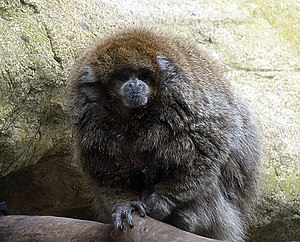White-eared jumper monkey
| White-eared jumper monkey | ||||||||||||
|---|---|---|---|---|---|---|---|---|---|---|---|---|

White-eared Spring monkey ( Plecturocebus donacophilus ) |
||||||||||||
| Systematics | ||||||||||||
|
||||||||||||
| Scientific name | ||||||||||||
| Plecturocebus donacophilus | ||||||||||||
| ( d'Orbigny , 1836) |
The white-eared jumper monkey ( Plecturocebus donacophilus , syn .: Callicebus donacophilus ) is a species of primate from the subfamily of jumper monkeys within the family of sakia monkeys (Pitheciidae).
features
White-eared jumper monkeys, like all jumper monkeys, are relatively small primates with fluffy fur and a long, bushy tail. They reach a head body length of 31 to 34 centimeters, the tail becomes a little longer. The weight is approximately 0.8 to 1.2 kilograms. Their fur is orange-gray in color on the top of the head, on the back and on the outside of the limbs, the belly is orange or brown-orange. The tail is dense with yellow-brown hair, it cannot be used as a prehensile tail, as with all jumper monkeys. The distinctive white tufts of ears are characteristic of its name.
distribution and habitat
White-eared juggler monkeys inhabit the flatter parts of the country in eastern Bolivia ( Beni and Santa Cruz departments ) and the neighboring regions of Brazil ( Rondônia ). Their habitat are tropical rainforests .
Way of life
White-eared juggler monkeys, like all jumper monkeys, are diurnal tree inhabitants. You either move on all fours or jump through the branches. They live in family groups of two to seven animals made up of a long-standing monogamous couple and their offspring. They are territorial, with duet songs the couples point out other animals to their own territory.
Their diet consists primarily of fruits. To a lesser extent, they also consume leaves, seeds and insects.
After a gestation period of around five months, the female usually gives birth to a single young. As with all jumper monkeys, the father takes an intensive part in the rearing, he is the main carrier and only gives the child to the mother to suckle.
Danger
Although the white-eared jumper, like many other animals, suffer from the destruction of their habitat, they are not very demanding in terms of their habitat and have a relatively large range. The species is listed by the IUCN as "not endangered" ( least concern ).
Systematics
The white-eared jumper monkey is one of around 30 species into which the subfamily of jumper monkeys (subfamily) is divided. He is the namesake of the donacophilus group within the genus Plecturocebus , a group of rather small jumper monkeys that also includes the Rio-Beni jumper monkeys , the Andean jumper monkeys , the Beni jumper monkeys and the white-coat jumper monkeys . The white-mantled jumper monkey ( P. pallescens ) used to be a subspecies of the white-eared jumper monkey.
literature
- Thomas Geissmann : Comparative Primatology. Springer-Verlag, Berlin a. a. 2003, ISBN 3-540-43645-6 .
- Marc GM van Roosmalen, Tomas van Roosmalen, Russell A. Mittermeier: A Taxonomic Review of the Titi Monkeys, Genus "Callicebus" Thomas 1903, with the description of two new species: "Callicebus bernhardi" and "Callicebus stepehnnashi", from Brazilian Amazonia . (PDF; 3 MB) In: Neotropical Primates. 10, ISSN 1413-4703 , 2002, pp. 1-52.
- Don E. Wilson, DeeAnn M. Reeder (Eds.): Mammal Species of the World. A taxonomic and geographic Reference. Johns Hopkins University Press, Baltimore MD 2005, ISBN 0-8018-8221-4 .
Web links
- Plecturocebus donacophilus in the endangered Red List species the IUCN 2009. Posted by: L. M. Veiga, R. B. Wallace, S. F. Ferrari, 2008. Accessed on 5 November of 2009.
- Information at Theprimata.com
